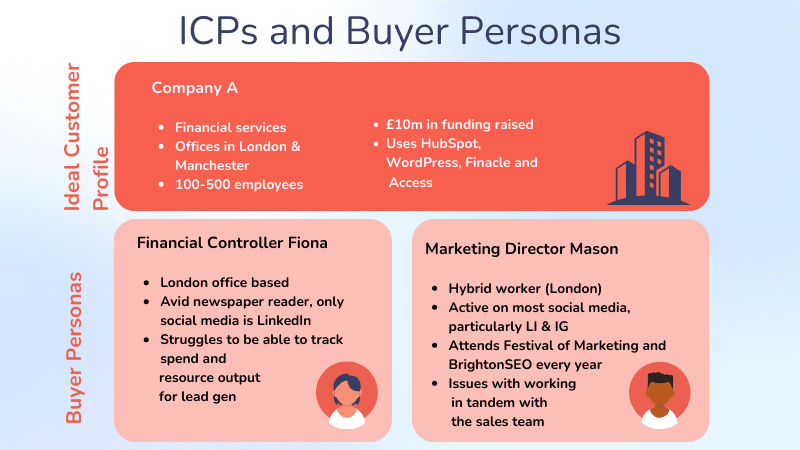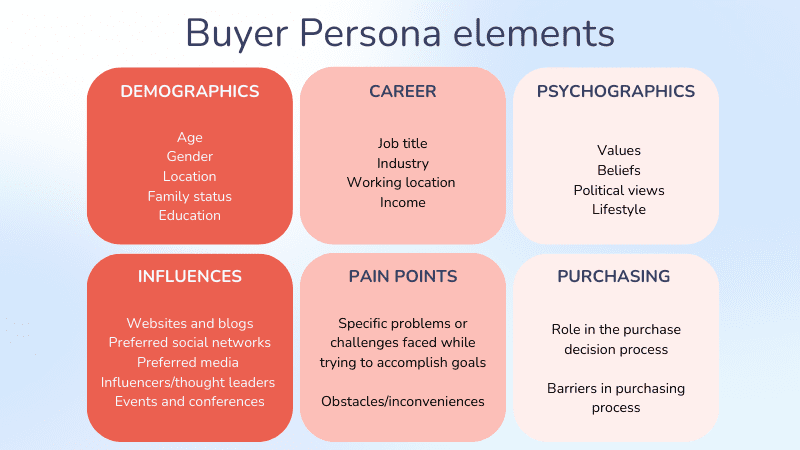Ideal customer profiles and buyer personas: What’s the difference?

Ideal customer profiles and buyer personas are two different but related concepts. Find out how to utilise them together for better sales and marketing output!
At its core, marketing is about getting to know your customers so you can tell them persuasive stories about improving an aspect of their lives. Knowing their pain points, needs and desires, and likely objections is vital to telling stories that resonate.
It’s for this reason that ideal customer profiles and buyer personas are part of the sales and marketing toolkit. But without a clear differentiation between the two – or too much focus on one over the other – the power and potential of these tools are not realised.
Stick with us as we cover what they are, how they work together, and how they can benefit your business.
Ideal Customer Profiles (ICP) – a breakdown
Commonly known as an ICP (because acronyms are king), its sole purpose is to provide a clear picture of the types of businesses your product or service can help with. An ICP comprises a list of qualities a prospective company must have to be in your total addressable market. It is a prerequisite for them to convert and buy from you.
Most businesses typically identify several ICPs to capture the variety of customers who might benefit from their products or services, reflecting the different segments within their target audience. Each ICP represents a specific group with unique characteristics, challenges, and goals.
By doing this, you can create marketing that really clicks with each group, leading to better engagement and more sales.
Distinct customer profiles enable you to pinpoint the specific challenges your business tackles, ensuring your offerings resonate with potential customers, and play a key role in guiding the evolution of your products and services.
For effective marketing and sales strategies, it’s crucial to have tightly defined market segments. Broad categories like “Large Enterprises” are too general.
On the other hand, targeting something specific, such as “Healthcare Providers with 500-1,000 employees using cloud-based patient management systems” is useful. It’s well-defined enough that you can build a marketing campaign to target it.
Some of the key characteristics that can map out your ICP can include:
| Company size | Number of employees, annual revenue. |
| Industry or sector | Specific industries the company operates in. |
| Geographic location | Where the company is based or operates. |
| Decision-maker characteristics | Job titles and roles of key decision-makers. |
| Pain points and challenges | Specific problems the company faces that you can solve. |
| Buying process | How they typically make purchasing decisions. |
| Budget | Typical budget range for relevant products/services. |
| Goals and objectives | Key business goals and objectives. |
In its simplest form, your ICP is an excellent toolkit for your marketing and sales teams. It will help them identify if prospects align with these characteristics, so they can categorise and prioritise leads by best to least perfect fit.
Buyer Personas – a breakdown
A buyer persona is a generalised representation of your ideal customer. They are typically built around the personal aspects and career history of that person, and the challenges they face in their day-to-day business lives.
The next layer that builds out your buyer persona is identifying where they consume information that will help with their business needs – where you can reach them with targeted messaging. This offers further valuable insight into what their buying process might look like.
On average, there are 3.6 stakeholders in the B2B decision-making process, so you will have more than one persona influencing your sale, but there will often be a key stakeholder you should consider first.
Some of the key characteristics that can map out your buyer persona include:
| Job title and role | Specific job titles and roles within the target company. |
| Professional background | Key experience, skills, and career highlights. |
| Day-to-day responsibilities | Core tasks and responsibilities in their role. |
| Challenges and pain points | Specific work-related problems and challenges they face. |
| Goals and objectives | Professional goals and objectives they aim to achieve. |
| Decision-making influence | Their role and influence in the buying process. |
| Preferred communication channels | How and where they prefer to receive information (e.g., email, LinkedIn). |
| Content preferences | Types of content (e.g., whitepapers, case studies) that resonate with them. |
| Budget authority | Their role in budget decisions and typical budget constraints. |
Boiling it down, your buyer persona is built to aid your marketing teams in mapping out and creating content that prospective clients will see. It’s all about finding that type of client where they are and providing them with the information that will pique initial interest.
How do they work together?
In trying to balance customer profiles vs buyer personas, businesses can often spend way too much time on the personas and not nearly enough time on the ICPs.
ICPs allow us to take a potentially large market and split it into distinct groups of buyers. Imagine you sell to the Financial Services market. Within that, you can break down the total market into sub-segments like “commercial banks”, “investment firms”, and “insurance companies”.
Personas allow us to think about the people within those profiles that we need to connect with. While B2B sales teams sell to businesses, it’s the people working at those businesses they need to connect with.
So within our different finance segments, the personas might include the Branch Managers for commercial banks, Portfolio Managers for investment firms, and risk assessment analysts for insurance companies.

How to build your ICPs
Your ICPs are an invaluable tool for your sales team, helping them identify those smoking hot leads. It can help the product and R&D teams understand how they can adapt and improve the product to accommodate those on the market who will benefit the most – and bring the return.
To not over-complicate it, three key elements will need to be identified:
- Pull out your super users
- Collect key data
- Bring it all together for great analysis
To start building your ICP, you must understand where you’ve got it right. Dive into your customer data: build a list of the current users of your product/service and pick out those who are getting the most out of it, either in terms of revenue and customer lifetime value or improvements to their offering.
Once you have selected your super users, you must conduct a mix of qualitative and quantitative data collection. This will give you a broad scope and will benefit your targeting in the long run.
One of the first forms of data collection is collecting customer feedback. This can come in all shapes and sizes, including surveys, reviews, a net promoter score, or, to get the juicy details, client interviews. If you’re considering them as a superuser, you will have already forged a great relationship. Make the most of it.
When conducting your interview, some of the questions you will need to ask to clarify your ICP can include:
- How much research did you do before committing to our product/service?
- Where did you go to gain further insight into our company and what we offer?
- How did you first hear about us?
- Who is the buying decision maker?
- What have been the most significant pain points you’ve encountered when offering your product/service?
- Does collaborating with us solve this pain point? How?
- What have been the benefits of choosing us as a solution? What made our collaboration a good fit?
Next stop: targeted data! This should be easier as it is often available. Open up your CRM, chat with the finance team, and analyse the results of paid promotional activity.
If you are running prospecting campaigns, they produce a wealth of data to aid your quest. In fact, our upcoming State of Prospecting 2024 report reveals that 72% of companies say prospecting significantly enhances their understanding of customer profiles and target markets.
The characteristics you will need to identify include:

Once satisfied with your data collection, you must bring it together and analyse it. Some of the questions you must ask to bring together an accurate picture of what your ICP looks like include:
- Are there recurring patterns?
- What are the shared characteristics?
- Is there anything that connects each business?
After compiling all of this information, pouring over it, and analysing it, it’s now time to start putting that ICP together. Yours might look slightly different based on the information you may have discovered. But here are some of the elements that are worth including to make sure your sales and customer-facing teams are always on the right track:
- The industry that they sit in
- Location of the business and areas they serve (if vastly different and helpful)
- Company size
- The budget they’re working with
- Key decision-makers within the company
- Pain points common in their role or for their business
- Overarching business goals
- Any tech or software that they may already be using
Don’t forget to jazz it up a little – engage your teams by creating a visual graphic. Develop an ICP that is easy to reference and, more importantly, accessible and will benefit the business and products.

How to create a B2B ideal customer profile
Creating an ideal customer profile for your B2B business can focus marketing, increase sales and reduce churn. Here’s how to create one.
Read the guideHow to create your buyer persona
Taking steps to bring your persona together isn’t too dissimilar from formulating your ICP, so you may have already collected some of this data. We love a quick win.
Initially, you must use different research sources to gather the necessary data. To get a broad view of what your buyer persona will look like, we recommend getting stuck into the following:
- Create surveys for your pre-existing client base, bring together focus groups for valuable conversations, or even conduct interviews with your customers who have had the most success working with you.
- Utilise any direct customer feedback. Your sales teams should be able to help you with this, but you can also get a lot of information from online reviews or interactions across social media.
- Social media is your friend. It enables you to track conversations and interactions. You’ll be able to find out how people are discussing your business or the industry. LinkedIn also will give you a personalised view of individuals.
- Although less insightful than direct feedback from your clients, your CRM and website are still valuable resources – and they’re right at your fingertips. These tools can help you add further detail on consumer behaviours, preferences, and interests.
Now you know where to look for valuable information and insights to build your buyer persona, what data do you need to collect? To give you the broadest picture possible, you need to understand demographics, professional information, psychographics, influences, pain points and their purchasing process.
Let’s break this down by each element:

All of this information is integral to shaping what your buyer persona will come to look like. It will help you better define the needs of your product and service and your strategies for any outbound communication. It will not only aid you in your reach but also help retain existing customers.

How to create accurate B2B buyer personas
Creating B2B buyer personas can help to focus your marketing efforts on the market segments that really matter. Find out how in this post.
Read the guideTargeting the right people at the right time
Don’t settle for having just an ICP or a buyer persona – you really need to have both in your arsenal. Incorporating these tools into your sales and outbound marketing strategies is crucial.
Done well, the two tools work together to focus your marketing efforts to connect with your perfect customers. Your ICP guides you on what businesses to target, while your buyer personas help you craft content that sells.
How do you then reach out to those people and start selling? For us and hundreds of our clients, multi-channel prospecting is the best way to reach the right person, in the right place, at the right time.
Looking for a lead generation agency for financial services companies? Or maybe you’re after a lead generation agency for training and coaching services. Look no further than Sopro. We’ll develop messaging that resonates with the decision-makers who control the purse strings.




Share